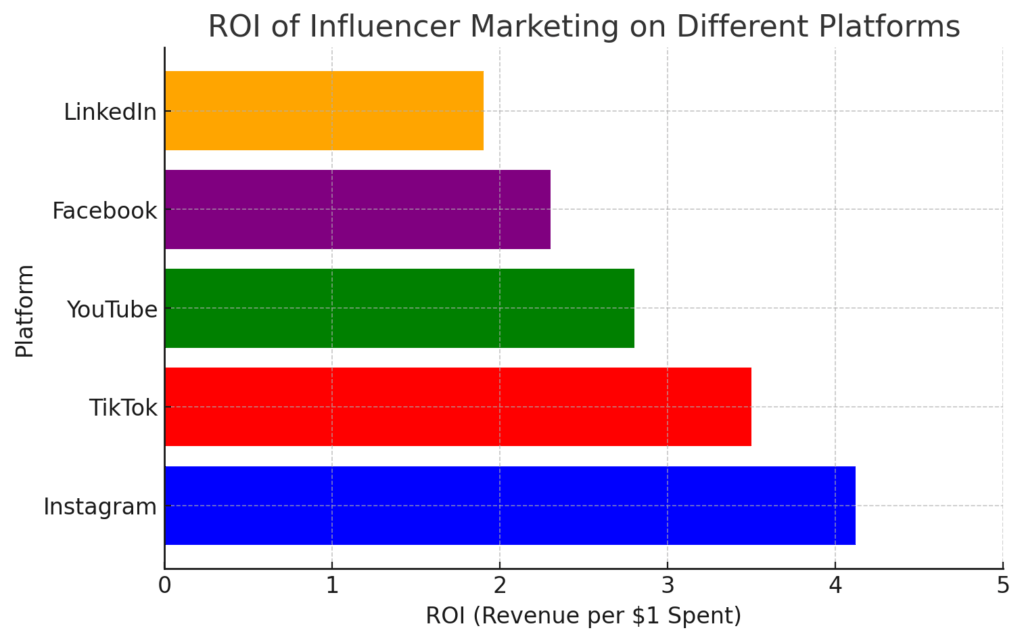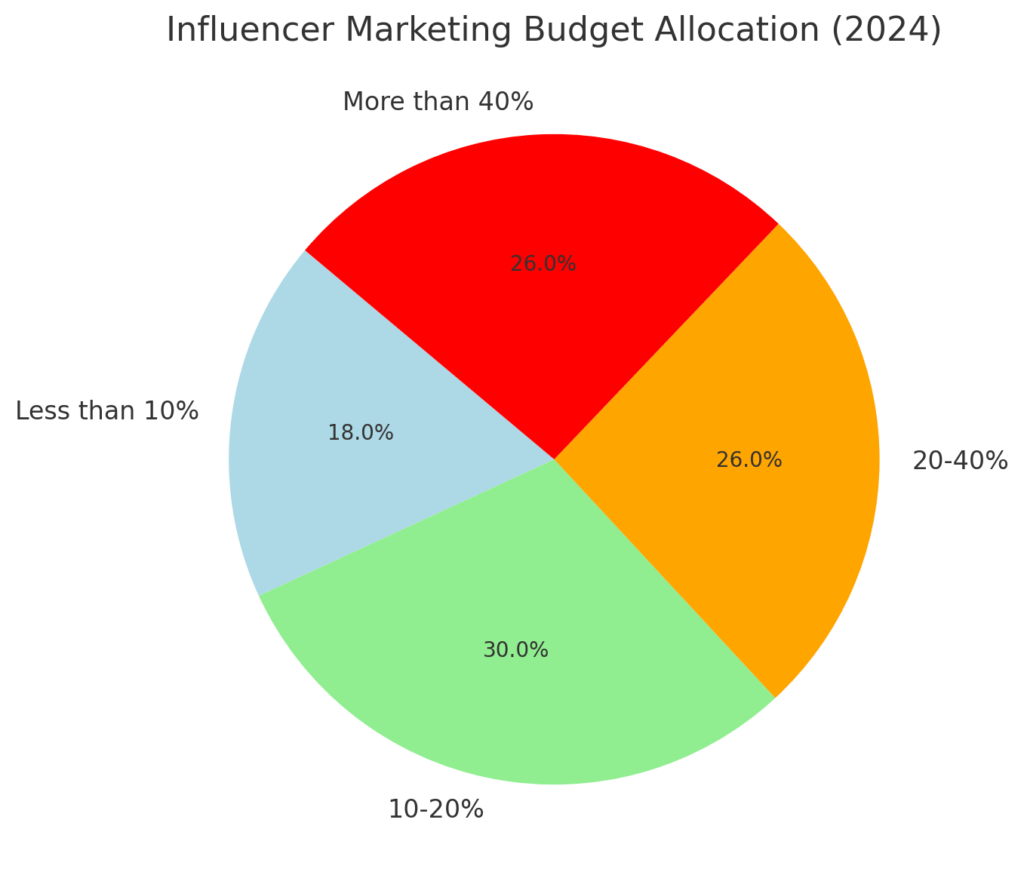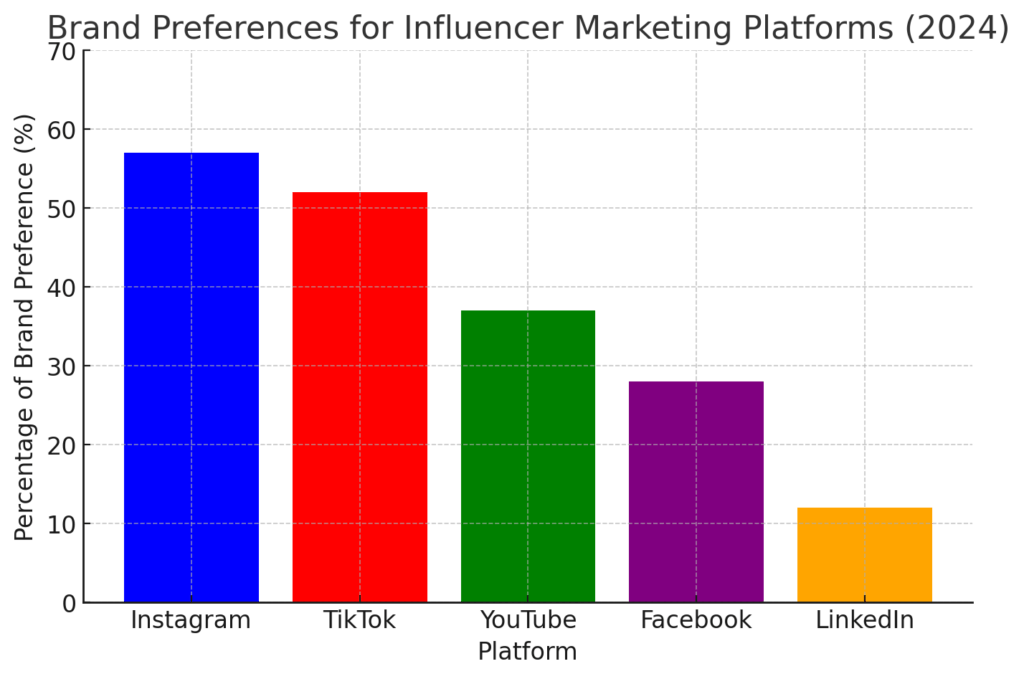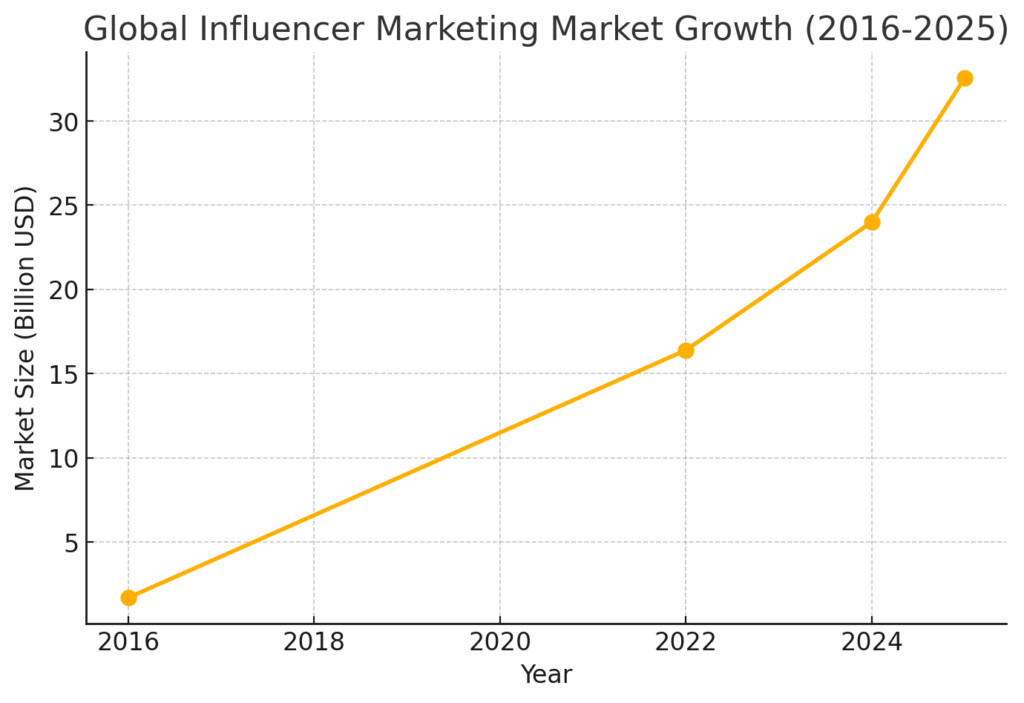
09 Mar TOP INFLUENCER MARKETING STATISTICS 2025
Influencer marketing has transformed from a niche strategy into a dominant force in digital advertising, reshaping how brands connect with consumers. As social media platforms evolve and user behaviors shift, companies are allocating larger budgets to influencer partnerships, prioritizing engagement over traditional ad spend. The rapid expansion of the creator economy, regulatory interventions, and advancements in AI-driven analytics are further shaping the landscape. While influencers wield significant power in driving purchasing decisions, issues like fraud, platform dominance, and regional disparities create new challenges. With projections indicating continued growth, Amra and Elma aims to help businesses refine their influencer marketing strategies to remain competitive. The following statistics highlight key trends, offering insights into where the industry is heading and what brands need to consider moving forward.
TOP INFLUENCER MARKETING STATISTICS 2025 (Editor’s Choice)
Influencer marketing has experienced significant growth over the years and continues to evolve as a pivotal component of digital marketing strategies. Here are 20 key statistics highlighting its trajectory and projections for 2025:
1. Market Growth: The global influencer marketing market value stood at $21.1 billion in 2023, having more than tripled since 2019.
2. Future Projections: The influencer marketing industry is set to be worth $48 billion by 2027, indicating a substantial increase from its current valuation.
3. Adoption by Marketers: In 2021, nearly 70% of U.S. marketers in companies with over 100 employees utilized influencer marketing. This percentage is expected to reach 86% by 2025.
4. Budget Allocation: As of February 2024, 26% of global marketing agencies and brands allocated more than 40% of their marketing budgets to influencer partnerships.
5. Spending in the U.S.: Influencer marketing spending in the U.S. reached $7.02 billion in 2023 and is projected to grow to $9.29 billion by 2025.
6. Consumer Trust: 63% of consumers are likely to buy products from an influencer they trust, emphasizing the importance of authenticity in influencer collaborations.
7. User-Generated Content (UGC) Influence: 86% of consumers say authenticity is important when deciding which brands to support, and 60% believe UGC is the most authentic and influential when making purchasing decisions.
8. Engagement Rates: Micro-influencers, those with fewer than 1,000 followers, achieve an 8% like rate on their posts, compared to 1.6% for those with over 10 million followers.
9. Platform Dominance: Instagram and TikTok continue to lead as the most popular platforms for influencer marketing, with brands like Netflix generating significant earned media value through these channels.
10. Creator Economy: In 2023, the U.S. had 27 million paid content creators, with 12 million doing it full-time, highlighting the expanding creator economy.
11. Regulatory Measures: In August 2024, the Federal Trade Commission banned marketers from using fake online reviews and inflated social media influence, aiming to enhance transparency in influencer marketing.
12. Influencer Fraud: Influencer fraud, including fake followers, was estimated to cost businesses up to $1.3 billion, about 15% of global influencer marketing spending.
13. Brand Collaborations: Over 60% of global brands have used influencers in marketing, indicating widespread adoption of this strategy.
14. Influencer Earnings: While top-tier influencers can earn six- or seven-figure fees for single posts, only 4% of all influencers make more than $100,000 a year.
15. Consumer Behavior: 54% of social media users utilize these platforms to research and validate online purchases, with 71% being more likely to purchase a product based on influencer recommendations.
16. Influencer Platforms: Platforms like LTK have connected over 8,000 retailers with 40 million monthly shoppers, showcasing the infrastructure supporting influencer marketing.
17. Investment in Influencer Tech: Influencer marketing platforms are attracting significant investments, such as ShopMy raising $77.5 million to expand into new ad categories.
18. Regional Variations: In countries like Germany, only about 20% of men and 33% of women follow influencers on social media, indicating regional differences in influencer impact.
19. Content Authenticity: User-generated content encourages more engagement, builds trust with consumers, and provides SEO value for brands, leading to increased conversions.
20. Influencer Marketing Budgets: In 2025, over half of brands plan to significantly increase budget allocations to influencer marketing, aiming for more prominence within their marketing strategies.
These statistics underscore the growing significance and evolving dynamics of influencer marketing as we approach 2025.

TOP INFLUENCER MARKETING STATISTICS 2025 and Future Implications
TOP INFLUENCER MARKETING STATISTICS 2025 #1. Market Growth:
The influencer marketing industry has seen exponential growth, reaching a valuation of $21.1 billion in 2023. This surge highlights how brands increasingly allocate resources to social media creators instead of traditional advertising. The shift is driven by higher engagement rates, targeted audience reach, and the perceived authenticity of influencers. As digital consumption rises, brands are expected to integrate influencers even deeper into their marketing strategies. However, with this expansion, competition will increase, requiring businesses to be more strategic in selecting partnerships. New regulatory measures may also emerge to ensure transparency and credibility in the industry. Moving forward, influencer marketing will likely become an integral part of omnichannel campaigns rather than just a standalone tactic.
TOP INFLUENCER MARKETING STATISTICS 2025 #2. Future Projections:
By 2027, influencer marketing is projected to be worth $48 billion, more than doubling its current value. This rapid expansion suggests that brands will continue prioritizing influencers in their marketing budgets. With the rise of AI-driven content creation and automation, influencer collaborations may become even more data-driven, improving targeting precision. As platforms like TikTok and Instagram evolve, brands will need to adapt to changing algorithms and content formats. The financial growth also signals more investment in creator economy startups, influencer management platforms, and monetization tools. While opportunities abound, saturation in the market could lead to declining engagement rates, forcing brands to innovate. Marketers who harness long-term influencer relationships rather than one-off campaigns will likely see the highest ROI.
TOP INFLUENCER MARKETING STATISTICS 2025 #3. Adoption by Marketers:
By 2025, 86% of U.S. marketers in companies with over 100 employees are expected to use influencer marketing. This increase reflects a broader recognition of social media’s power in driving consumer behavior. The growing reliance on influencers will push brands to refine their collaboration strategies, focusing on authenticity over mere reach. As influencer marketing matures, businesses may shift towards nano- and micro-influencers, who typically have higher engagement rates. Traditional advertising methods like television and print media may continue to decline as digital takes center stage. Additionally, B2B brands, which were slower to adopt influencer marketing, will likely follow the trend. With more brands entering the space, finding the right influencers will become increasingly competitive, requiring data-driven selection methods.
TOP INFLUENCER MARKETING STATISTICS 2025 #4. Budget Allocation:
As of 2024, 26% of brands and agencies allocate over 40% of their marketing budgets to influencer partnerships. This significant investment underscores the effectiveness of influencer-driven campaigns in delivering measurable results. Brands shifting large portions of their budgets to influencers suggests a decline in reliance on traditional media. Social media platforms will likely capitalize on this trend by introducing more monetization options for creators. However, as budgets rise, brands will also demand greater transparency and performance metrics from influencers. The shift could lead to stricter contracts, more performance-based partnerships, and increased scrutiny of influencer analytics. Ultimately, this budgetary expansion signals a new era where influencer marketing is seen as a core, rather than supplementary, strategy.
TOP INFLUENCER MARKETING STATISTICS 2025 #5. Spending in the U.S.:
U.S. influencer marketing spending is projected to grow from $7.02 billion in 2023 to $9.29 billion by 2025. This growth aligns with brands increasingly allocating their advertising dollars to digital and social media strategies. The steady increase suggests that brands are seeing strong returns from influencer-driven content. However, the rise in spending could also lead to inflation in influencer rates, making campaigns more expensive. With this trend, brands may seek alternative forms of partnerships, such as revenue-sharing models, rather than upfront payments. AI-driven analytics will become more crucial in ensuring ROI as brands invest larger budgets. If the trend continues, influencer marketing could rival traditional digital advertising channels in terms of investment.

TOP INFLUENCER MARKETING STATISTICS 2025 #6. Consumer Trust:
Trust plays a critical role in influencer marketing, with 63% of consumers likely to purchase from influencers they trust. This trust factor highlights the importance of authenticity, which is increasingly valued over polished brand messaging. Consumers are becoming more skeptical of overtly promotional content, preferring genuine product recommendations. Moving forward, influencers who maintain transparency with their audiences will likely outperform those who engage in excessive brand deals. Brands will also need to vet influencers more carefully to ensure alignment with their values and messaging. As consumers demand more ethical marketing, regulators may enforce stricter guidelines on sponsored content disclosures. Those who prioritize trust and long-term relationships with audiences will have a lasting impact.
TOP INFLUENCER MARKETING STATISTICS 2025 #7. User-Generated Content (UGC) Influence:
UGC is a key driver of purchasing decisions, with 60% of consumers favoring it for authenticity. This growing preference suggests that brands should integrate more consumer-generated content into their marketing strategies. Influencers who incorporate UGC into their campaigns will likely see higher engagement and credibility. Social media platforms are also optimizing algorithms to boost organic UGC reach, making it even more valuable. Brands that leverage UGC alongside influencer marketing will create a more authentic digital presence. However, quality control remains a challenge, as not all UGC aligns with a brand’s image. Future advancements in AI may help brands curate and enhance UGC to maximize impact.
TOP INFLUENCER MARKETING STATISTICS 2025 #8. Engagement Rates:
Micro-influencers, those with under 1,000 followers, achieve an 8% like rate compared to 1.6% for influencers with over 10 million followers. This suggests that smaller influencers foster deeper connections with their audiences. Brands are increasingly prioritizing engagement over follower count, leading to a rise in micro- and nano-influencer partnerships. These influencers offer more cost-effective collaborations while driving higher conversion rates. As social media algorithms favor authentic interactions, influencer marketing strategies will need to shift towards more meaningful engagement. The trend also suggests that brands should invest in multiple small influencers rather than a single mega-influencer. Future campaigns will likely blend influencer tiers to balance reach and engagement.
TOP INFLUENCER MARKETING STATISTICS 2025 #9. Platform Dominance:
Instagram and TikTok continue to dominate influencer marketing, with brands like Netflix leveraging these platforms for high engagement. The preference for short-form video content has reshaped how brands approach digital advertising. TikTok’s algorithm-driven discovery makes it a prime platform for viral influencer campaigns. Meanwhile, Instagram’s investment in features like Reels keeps it competitive. Moving forward, brands must stay adaptable, as platform preferences can shift with new technological advancements. Emerging platforms, such as decentralized social media networks, could challenge the dominance of these giants. Those who strategically diversify their influencer partnerships across multiple platforms will remain resilient to algorithm changes.
TOP INFLUENCER MARKETING STATISTICS 2025 #10. Creator Economy Growth:
The U.S. had 27 million paid content creators in 2023, with 12 million earning a full-time income. This explosion in the creator economy reflects how influencer marketing has become a legitimate career path. More individuals are monetizing their content through brand deals, subscription models, and affiliate marketing. As social media platforms introduce more revenue-sharing features, the number of full-time creators is expected to grow. However, increased competition means creators must differentiate themselves to sustain income. Brands will also need to refine their selection processes, as more people enter the space. Future advancements in AI-generated content may further impact how creators produce and distribute material.

TOP INFLUENCER MARKETING STATISTICS 2025 #11. Regulatory Measures:
In August 2024, the Federal Trade Commission (FTC) banned fake online reviews and inflated social media influence. This move signals a growing effort to ensure transparency in digital advertising. As influencer marketing matures, regulatory bodies will likely impose stricter guidelines on disclosures and sponsored content. Brands and influencers must now be more diligent in adhering to legal requirements, as violations could lead to hefty fines. This regulation will also push platforms to enhance their fraud detection tools, making it harder for influencers to buy fake engagement. As trust becomes a central factor in influencer marketing, those who operate with full transparency will gain a competitive edge. Future legal developments may introduce standardized contracts between brands and influencers to further professionalize the industry.
TOP INFLUENCER MARKETING STATISTICS 2025 #12. Influencer Fraud:
Fraud in influencer marketing, including fake followers and engagement, costs brands up to $1.3 billion annually. This issue has led to increased skepticism among marketers, forcing them to adopt stricter vetting processes. As influencer budgets grow, brands will demand better verification tools and performance tracking. AI-powered fraud detection is already being integrated into influencer platforms, allowing brands to identify inauthentic accounts. Moving forward, influencers who engage in fraudulent practices may find themselves blacklisted from brand partnerships. The crackdown on influencer fraud could also shift industry focus toward long-term partnerships with trusted creators rather than one-off collaborations. Transparency in performance metrics will become a major factor in influencer selection, ensuring brands get genuine value for their investments.
TOP INFLUENCER MARKETING STATISTICS 2025 #13. Brand Collaborations:
Over 60% of global brands have utilized influencers in their marketing strategies, showing mainstream adoption. This widespread integration suggests influencer marketing is no longer experimental but a core component of brand outreach. Companies across industries, from fashion to finance, are recognizing the potential of influencers in building consumer trust. With competition increasing, brands will need to develop more unique and engaging influencer campaigns to stand out. As artificial intelligence enhances personalization, brands may start matching influencers with audiences based on deeper behavioral data. The high adoption rate also means influencers will have more bargaining power, leading to higher pricing for brand deals. Future innovations may include influencer-led product development, where creators have a direct role in designing branded merchandise.
TOP INFLUENCER MARKETING STATISTICS 2025 #14. Influencer Earnings:
Only 4% of influencers earn more than $100,000 annually, despite the perception that content creation is highly lucrative. This statistic highlights the income disparity in the creator economy, where top-tier influencers capture the majority of brand deals. As more people enter the space, competition for sponsorships will intensify, making it harder for new influencers to secure steady income. Platforms may introduce more monetization opportunities, such as revenue-sharing from ads and digital tipping features. Brands, in turn, might prefer micro-influencers who charge lower fees but offer higher engagement. This trend suggests that aspiring influencers will need to diversify their income streams, such as through affiliate marketing or digital products. The future of influencer earnings may involve a more structured approach, with contracts and performance-based pay models becoming the norm.
TOP INFLUENCER MARKETING STATISTICS 2025 #15. Consumer Behavior:
More than half (54%) of social media users research products online before purchasing, with 71% influenced by influencer recommendations. This consumer behavior underscores why brands prioritize influencer partnerships in their digital marketing strategies. As audiences rely more on social proof, influencer content will continue to shape purchasing decisions across industries. The rise of AI-powered recommendation engines could further personalize influencer marketing, making endorsements feel even more tailored. However, brands must ensure influencers align with their values, as authenticity remains a key factor in consumer trust. Companies that integrate influencer content into their official e-commerce platforms may see higher conversions. Looking ahead, influencer-driven shopping experiences, such as livestream commerce, will likely grow in popularity.

TOP INFLUENCER MARKETING STATISTICS 2025 #16. Influencer Platforms:
LTK, an influencer shopping platform, has connected over 8,000 retailers with 40 million monthly shoppers. This signals a shift towards structured influencer marketplaces that streamline brand collaborations. As influencer marketing grows, more platforms will emerge to facilitate direct partnerships between brands and creators. These tools will offer advanced analytics, allowing companies to track ROI more effectively. Additionally, the rise of social commerce means influencers will play a greater role in driving direct sales rather than just brand awareness. Brands will need to adapt to these platforms, ensuring their influencer campaigns align with real-time purchasing trends. The future of influencer marketing may see an increase in performance-based payments, where creators are compensated based on actual sales generated.
TOP INFLUENCER MARKETING STATISTICS 2025 #17. Investment in Influencer Tech:
Investor interest in influencer marketing platforms is surging, with startups like ShopMy raising $77.5 million to expand. This financial backing indicates that influencer-driven commerce is becoming a dominant force in digital advertising. As these platforms grow, they will offer brands more sophisticated targeting and automation tools. AI-powered influencer matching could revolutionize how brands select partnerships, optimizing campaigns for maximum impact. However, as more capital flows into influencer tech, traditional marketing agencies may struggle to compete. Companies investing in these platforms early will gain a competitive advantage in influencer-driven sales. Looking forward, we may see influencer marketing become fully integrated with broader ad-tech ecosystems.
TOP INFLUENCER MARKETING STATISTICS 2025 #18. Regional Variations:
Influencer impact varies by region, with only 20% of German men and 33% of German women following influencers. This disparity suggests that influencer marketing strategies must be tailored to cultural preferences. While markets like the U.S. and Asia have fully embraced influencer-driven commerce, European countries may require more localized approaches. Brands expanding internationally must consider regional differences in social media behavior and influencer credibility. Future influencer campaigns will likely involve multilingual content and culturally relevant messaging. As social media penetration increases in underrepresented regions, influencer marketing may gain traction in new demographics. Companies that invest in culturally nuanced influencer strategies will see better engagement and conversions.
TOP INFLUENCER MARKETING STATISTICS 2025 #19. Content Authenticity:
User-generated content (UGC) continues to be a trusted marketing tool, with brands integrating it to enhance authenticity. Consumers increasingly prefer organic, relatable content over highly polished advertisements. This shift means that brands must empower both influencers and regular customers to create and share content. The growing importance of UGC also presents challenges, such as maintaining brand consistency while allowing creative freedom. AI-driven moderation tools may help brands filter and curate high-quality user-generated content at scale. As UGC gains traction, brands may offer incentives for customers to create content, such as exclusive discounts or loyalty rewards. The future of marketing will likely blur the line between influencers and everyday consumers, making brand storytelling more decentralized.
TOP INFLUENCER MARKETING STATISTICS 2025 #20. Influencer Marketing Budgets:
More than half of brands plan to increase their influencer marketing budgets significantly in 2025. This signals a continued shift away from traditional advertising towards social media-driven campaigns. As competition intensifies, brands will need to develop more strategic, data-driven influencer collaborations. AI-powered insights will play a larger role in optimizing influencer partnerships for better performance. With bigger budgets, influencers may demand long-term contracts and higher pay, leading to more structured agreements. Additionally, performance-based compensation models could become more common, tying influencer earnings to actual sales or engagement. In the coming years, influencer marketing may become an essential line item in every major brand’s marketing strategy rather than just an experimental approach.
The Future of Influencer Marketing: Innovation, Trust, and Growth
Influencer marketing is no longer just a trend—it’s a central pillar of modern digital advertising. With market projections reaching $48 billion by 2027, brands are investing more in influencer-driven campaigns, shifting away from traditional advertising methods. However, as budgets grow, so do the expectations for transparency, performance tracking, and authenticity. The rise of AI-powered analytics, influencer marketplaces, and regulatory oversight will refine how brands collaborate with creators. Engagement rates will continue to favor micro-influencers, and user-generated content will play an even bigger role in shaping consumer trust. Looking ahead, the brands that succeed will be those that foster meaningful, long-term influencer relationships while adapting to platform shifts and emerging technologies. As the digital landscape evolves, influencer marketing will remain a powerful tool—one that’s constantly redefining how businesses and consumers connect.
Sources:
- https://www.statista.com/topics/2496/influence-marketing/
- https://www.dash.app/blog/influencer-marketing-statistics
- https://sproutsocial.com/insights/influencer-marketing-statistics/
- https://sproutsocial.com/insights/influencer-marketing-statistics/
- https://www.wsj.com/articles/influencer-marketings-m-a-streak-continues-with-mavely-sale-75845022
- https://www.dash.app/blog/influencer-marketing-statistics
- https://en.wikipedia.org/wiki/User-generated_content
- https://fr.wikipedia.org/wiki/Marketing_d%27influence
- https://www.businessinsider.com/top-brands-creator-marketing-social-media-2024-2025-2
- https://en.wikipedia.org/wiki/Influencer
- https://en.wikipedia.org/wiki/Influencer
- https://en.wikipedia.org/wiki/Influencer_marketing
- https://en.wikipedia.org/wiki/Viral_marketing
- https://en.wikipedia.org/wiki/Influencer
- https://en.wikipedia.org/wiki/Consumerism_and_social_media
- https://time.com/7177482/amber-venz-box-ltk-interview/
- https://www.wsj.com/articles/influencer-startup-shopmy-raises-77-5-million-to-expand-into-new-ad-categories-5ef297c4
- https://www.welt.de/253274592
- https://en.wikipedia.org/wiki/User-generated_content
- https://www.voguebusiness.com/story/companies/what-influencer-marketing-budgets-should-look-like-in-2025

